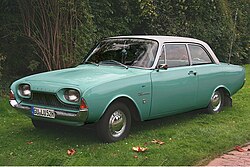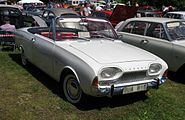Ford P3
| ford | |
|---|---|
|
Ford Taunus 17 M (1963)
|
|
| Taunus 17 M (P3) | |
| Production period: | 1960-1964 |
| Class : | upper middle class |
| Body versions : | Sedan , station wagon , convertible |
| Engines: |
Petrol engines : 1.5–1.75 liters (40–55 kW) |
| Length: | 4452-4517 mm |
| Width: | 1670 mm |
| Height: | 1450-1490 mm |
| Wheelbase : | 2630 mm |
| Empty weight : | 940-1015 kg |
| Previous model | Taunus 17 M (P2) |
| successor | Taunus 17 M (P5) |
The Taunus P3 or 17 M presented in 1960 is an upper middle class car from Ford Germany. Ford presented it in a new, factual form created by the designer Uwe Bahnsen , for which the slogan "Line of Reason" was coined.
Model history
General
With the Taunus P3, Ford left the trapezoidal line of the previous model P2 . The car had neither tail fins nor excessive chrome jewelry and looked more European again. It not only looked more businesslike, but was also significantly more economical and functional than its predecessor: The modified body shape resulted in 20% lower fuel consumption at higher speeds, as well as better acceleration values and a higher top speed. The raised windshield was heavily curved. The oval headlights resulted in a significantly better light distribution and intensity with low beam. Continuous longitudinal members of the all-steel body made them torsion-resistant, so that no reinforcements were required for the four-door version. However, the retained 6 V on-board voltage was not very advanced. The first gear of the P3 was also synchronized to improve ease of use. Ford had adopted the chassis with MacPherson struts and wishbones on the individually suspended front wheels and a rigid axle on leaf springs at the rear from the P2 without any major changes.
In addition to the sedan with two or four doors, there was the station wagon called “Tournament” by Ford , initially with raised rear lights on the edge of the roof, later with taillights placed on the fenders and finally with taillights inserted into the fenders. The station wagon had reinforced rear springs and larger tires. At times you could choose from three different tailgates : the first is hinged on the roof, the second is a door attached to the left side and the third is hinged on the floor of the car, the rear window had to be retracted with a crank to open the hatch.
During the entire construction period, the buyer had the choice between three engines (1498, 1698 and 1758 cm³) and a variety of color combinations of paint and interior fittings. The automatic clutch " Saxomat " was available on request for three-speed transmissions .
Technical specifications
The following models were available:
- 17 M 1500
- 17 M 1700
- 17 M / TS 1750
| Ford Taunus 17M / 17M / TS (P3) | |||||
|---|---|---|---|---|---|
| model | 17M
1.5 liters |
17M 1.7 liters |
17M / TS 1.75 liters |
||
| 09/61 - 08/64 | until 08/63 | from 09/63 | until 08/63 | from 09/63 | |
| engine | 4-cylinder in-line engine (four-stroke) | ||||
| Bore × stroke | 82 x 70.9 mm | 84 x 76.6 mm | 85.5 x 76.6 mm | ||
| Displacement | 1498 cc | 1698 cc | 1758 cc | ||
| Max. Performance at |
55 hp (40 kW) 4250 rpm |
60 hp (44 kW) 4250 rpm |
65 hp (48 kW) 4250 rpm |
70 hp (51 kW) 4500 rpm |
75 hp (55 kW) 4500 rpm |
| Max. Torque at |
111 Nm 2400 rpm |
129 Nm 2200 rpm |
139 Nm 2100 rpm |
140 Nm 2200 rpm |
144 Nm 2300 rpm |
| compression | 1: 6.8 | 1: 7.0 | 1: 8.4 | 1: 8.5 | 1: 8.6 |
| Carburetor | 1 downdraft carburetor Solex 32 PICP from 09/63 Solex 32 PDSIT 4 with automatic start |
1 downdraft carburetor Solex 32 PICP |
1 downdraft carburetor Solex 32 DPSIT with automatic starter |
1 downdraft carburetor Solex 32 PICP |
1 register downdraft carburetor Solex 32 DIDTA with automatic starter |
| Consumption per 100 km | 9.5 l - 10.5 l | 10 l - 11 l | 10 l | 11 l | |
Top speed (Taunomatic) |
136 km / h | 138 km / h | 140 km / h | 148 km / h | 154 km / h |
| acceleration | 22 sec | 20.5 sec | 17.5 sec | 17 sec | 15 sec |
| Tires | 5.90 - 13, tournament 510 6.40 - 13 | 5.90 S - 13 | |||
| Brakes | Drum brakes (230 mm Ø) from 04/63 on request and from 07/63 series front disc brakes (188 mm Ø) |
||||
| circuit | Steering wheel shift (with 3 or 4 gears) | ||||
| Tank capacity | 45 liters (in the rear) | ||||
| Front suspension | MacPherson struts, wishbones, stabilizer | ||||
| Rear axle suspension | Rigid axle on leaf springs, telescopic shock absorbers | ||||
| Electrical system | Battery 6 V / 76 Ah, alternator 180 W. | ||||
meaning
With this model, Ford was able to catch up with Opel’s registration numbers for a short time (number of P3s built 669,731, of which 86,010 station wagons). Several hundred vehicles of this series are still registered today (mostly with vintage approval).
Karosseriewerk Deutsch produced a convertible and a coupé variant in a very small number of around 150 pieces . Some Taunus P3 were in South Africa and Greece for pickup rebuilt.
The Taunus P3, which at the time was popularly known as the “bathtub” because of its shape, is now a design milestone. It was replaced by the Taunus 17 M of the P5 series .
Web links
- Ford classic car
- Ford M models 1952–1972
- Ford P3 Register
- Ford P3 homepage
- Historical test report Hobby 11/1960 : Pages 68/69 in Zwischengas.com (accessed March 3, 2016)
literature
- Tuchen, Bernd: Ford Taunus 17 M P3 - The history of the legendary "bathtub" , Verlag Dr. Faustus, Büchenbach 2007, ISBN 978-3-933474-45-2 .
Individual evidence
- ↑ Note: P3 = Project 3, d. H. the third new car construction from the Ford factory in Cologne since the end of the Second World War .
- ↑ Medium-heavy passenger car, new line . In: Motor vehicle technology 12/1960, pp. 494–495.
- ↑ https://www.youtube.com/watch?v=Vvurs72j5Ag
- ^ Weiterode: Joyride in the bathtub , YouTube channel of HNA-online from August 19, 2012
- ↑ Werner Oswald : German Cars 1945-1975 . Ed .: Motorbuch Verlag Stuttgart. 2nd edition 1976.





